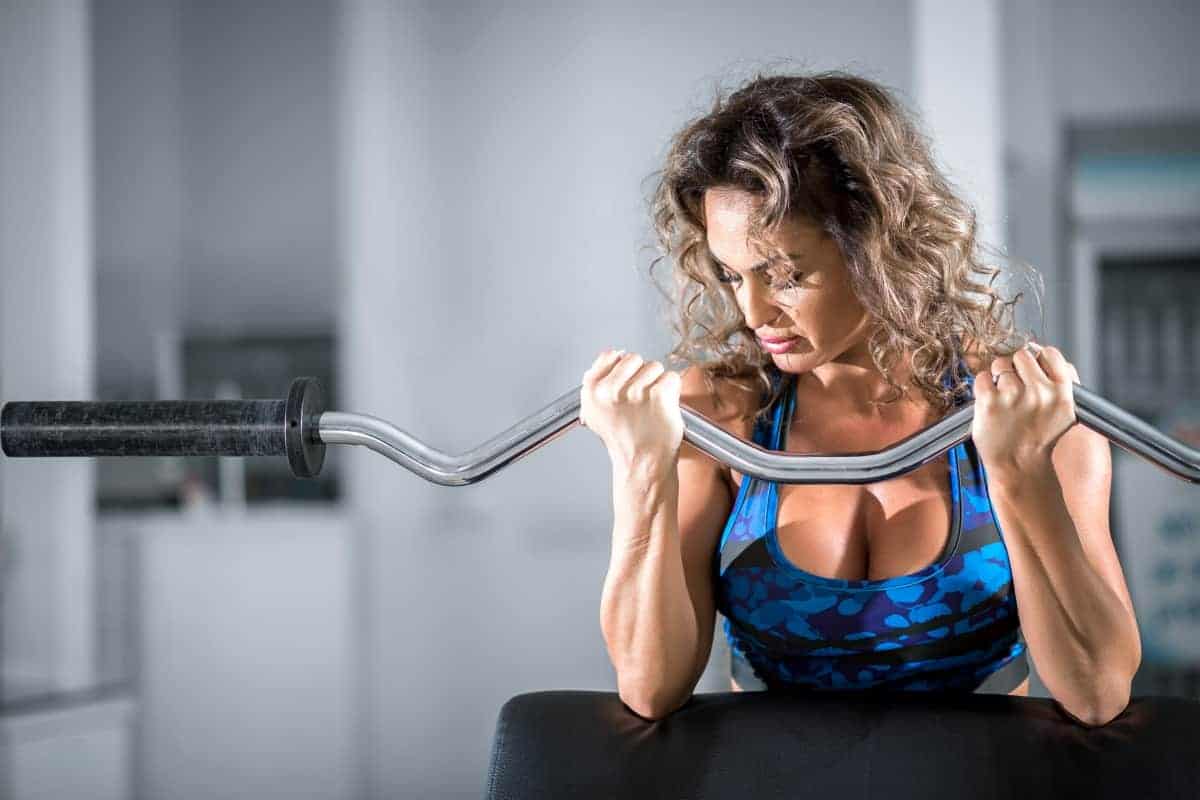In this article, 3 types of bicep exercises will be analyzed to best stimulate the anterior portion of the arm. Additionally, its anatomy, origin, and insertions will be mentioned.
Thanks to Valerius et al. (2013), we understand that the biceps brachii muscle is the most important flexor present in the elbow. Since its insertion is in the ulna, it does not produce any effect on the radioulnar joints.
This muscle originates in the distal two-thirds of the ventral surface of the humerus, in the intermuscular septum between the brachial muscle and the triceps brachii.
Additionally, it inserts into the ulnar tuberosity and the coronoid process of the ulna.
It is notable for its innervation in the musculocutaneous nerve, C5-C7, and the radial nerve, C5-C6. It also has the peculiarity of being innervated by the radial nerve despite being a flexor.
How to train bicep exercises?
Within the bicep exercises, we must highlight that the word Biceps comes from the Latin “Biceps brachii,” hence its name for having two heads at its origin, with the prefix “bi” meaning “double” and “ceps” referring to “heads” or “portions” (7).
Additionally, the biceps brachii has always been revered in male culture, even among warriors, and is currently often seen in bodybuilding evaluations (11).
Many users go to the weight room or gym for health, aesthetic, sports, rehabilitation, or muscle mass gain purposes. In this way, it is observed that strengthening the biceps brachii is highly requested, whether using machines, pulleys, dumbbells, or bars, performing bicep exercises in standing or seated positions, unilaterally or bilaterally (9).
For his part, Barón Sandoval, A. (2020), mentions that when performing bicep exercises, not only is the anterior arm musculature engaged, but also the forearm muscles are involved. However, this article will only refer to the biceps brachii, coracobrachialis, brachialis, and brachioradialis muscles.
Musculature and functions of the biceps
Our biceps brachii is located alongside the coracobrachialis, being topographically of the elbow, despite being functionally very important in the scapulohumeral joint according to Richardson, (2011).
We can highlight that it is divided into 2 parts called heads:
- Short head: originates at the coracoid process, descends vertically, and continues in the same place with the muscle fibers.
- Long head: originates at the supraglenoid tubercle of the scapula, entering the intertubercular groove and then continuing with fusiform fibers; highlighting that this portion is the most extensive.
Both portions unite in the first lower third of the diaphysis forming a tendon, which continues and ends expanding through the superficial aponeurosis of the forearm. The other tendinous part ends at the bicipital tuberosity of the radius.
Regarding functions, it is worth noting that our biceps brachii is present in multiple daily actions. Even so, we can differentiate the actions according to the area where they will be executed, depending on whether it is on the shoulder girdle, on the elbow, or on both.
- With the forearm fixed, it produces elbow flexion.
- With the forearm free, supination occurs.
- With the elbow fixed, it acts on the shoulder girdle, differentiating functions between the short head, being a flexor, internal rotator, and coaptator; versus the long head, which is anatomically dislocating and in abduction position is coaptating, in addition to producing external rotation.
What muscles are activated in bicep exercises?
Within bicep exercises, the anterior portion of the arm is the one that takes most of the work, composed of three muscle groups: the biceps brachii (short and long head), the coracobrachialis, and the brachialis, as these will be the ones that mostly work in bicep exercises.
The biceps brachii has two heads, the long head (originates at the supraglenoid tubercle of the scapula) and the short head (originates at the apex of the coracoid process), and is located superior to the brachialis muscle (11).
It inserts into the radial tuberosity, and as main functions; it is a powerful flexor of the forearm on the elbow joint and is a supinator of the forearm, in addition to being an accessory flexor of the arm at the glenohumeral joint (3 and 11).
Therefore, this muscle is known as polyarticular, as it crosses several joints, such as the elbow and shoulder (6 and 8).
On the other hand, the coracobrachialis, with its origin at the apex of the coracoid process, has the function of flexing the arm at the glenohumeral joint (3 and 11).
The brachialis muscle originates in the distal half of the anterior surface of the humerus and is located below the biceps brachii. Additionally, it inserts into the ulnar tuberosity (3 and 8). This muscle, flexes the forearm at the elbow joint. Therefore, it is known as a monoarticular muscle (6).
Another important muscle, which fulfills the function of flexing the forearm over the elbow and bringing it to supination and pronation, is the brachioradialis, which originates at the internal and external border of the distal end of the humerus (14).
In this way, in image nº1, the main muscles mentioned within the bicep exercises are observed.
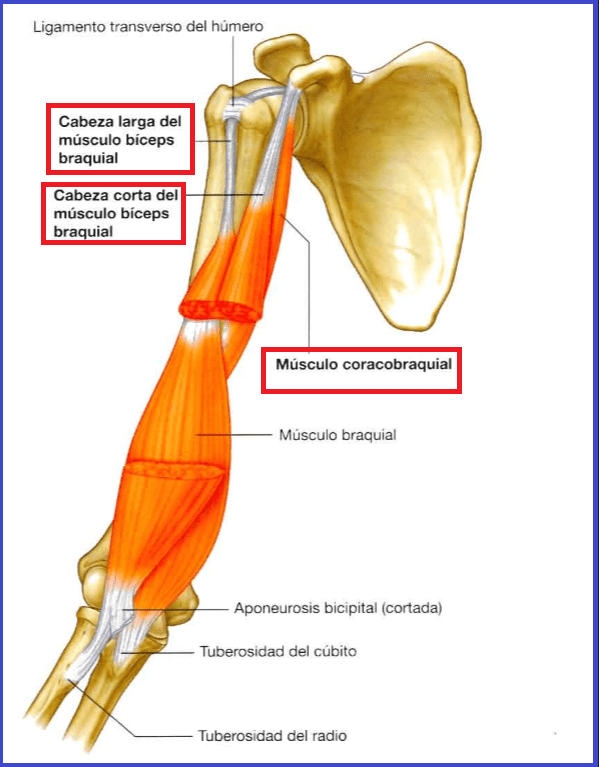
That said, other muscle groups, in addition to those mentioned, participate in elbow flexion (biceps brachii, brachialis, and brachioradialis) and elbow extension (triceps brachii and anconeus), knowing that it is a hinge joint, but if the emphasis of work is towards the triceps brachii, the priority will be elbow extension.
That said, we will begin to explain the 3 types of bicep exercises, which will emphasize bicep exercises with bars, dumbbells, and pulleys.
3 types of bicep exercises
There is no doubt that the anterior arm musculature is very important for increasing muscle mass, and it is also involved in traction bicep exercises. To this end, they will also have their stimulation. In this section, the selection of bicep exercises will be discussed, which will be presented with bars, dumbbells, and pulleys.
Standing barbell bicep curl
It is one of the first bicep exercises, as it is important to consider the disposition of the elbow joint, where all trainees will present different morphologies (6).
That said, this exercise is characterized by lifting the bar with elbow flexion up to chest height and lowering it with elbow extension (15).
The important technical points are:
- Standing, with a straight back, the bar is taken with a supinated grip, slightly wider than shoulder-width.
- Feet shoulder-width apart, with eyes facing forward (9).
- Inhale during elbow flexion and exhale during elbow extension.
- The musculature involved: the biceps brachii, the brachialis, and to a lesser extent, the brachioradialis, pronator teres, and the wrist and finger flexors (5).
- The movement should be slow and controlled, keeping the chest expanded, avoiding shrugging the shoulders.
To perform the bicep curl exercise, it is essential that during inhalation, an isometric contraction of the glutes, abdominals, and spinal muscles occurs (6), thus maintaining a proper posture and avoiding pivoting movement on the lower back (15).
Additionally, it avoids a hyperlordotic position at the end of the concentric phase, as this movement generally occurs with loads that exceed the level of strength that the elbow joint can generate or that the trainee can support (9).
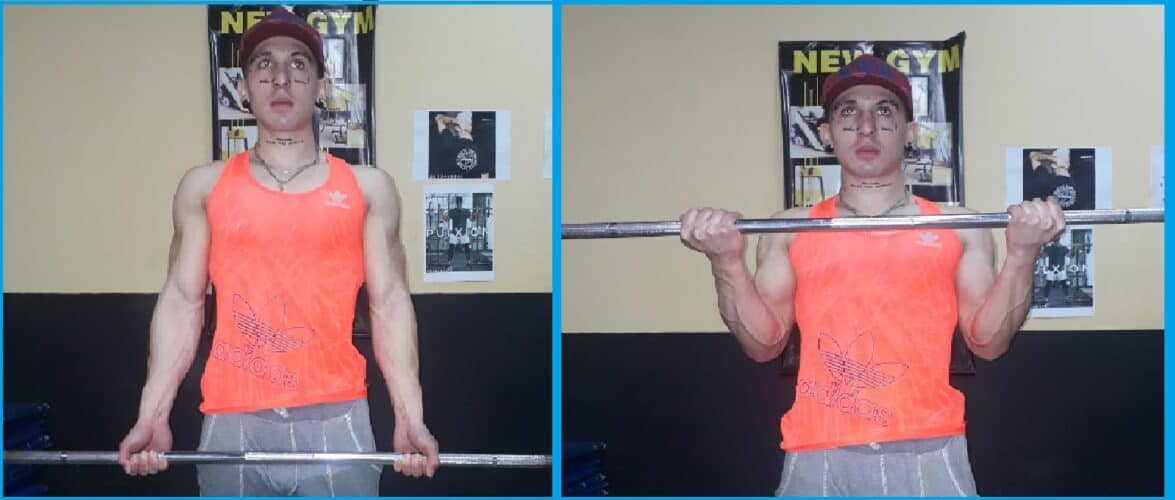
Some variations within bicep exercises
In these bicep exercises, you can combine hand separation, back support against the wall, or a slight trunk swing.
- With hands very separated, the stimulus is taken by the short head of the biceps, and with hands very close, the long head of the biceps.
- If the elbow is raised at the end of the flexion, the anterior deltoid and biceps receive more stimulus.
- Another way is to perform it strictly by supporting the back against the wall.
- Another variation is the use of bars, a Roman bar or “W” bar, in the case of people with elbow valgus, to avoid causing wrist pain (5).
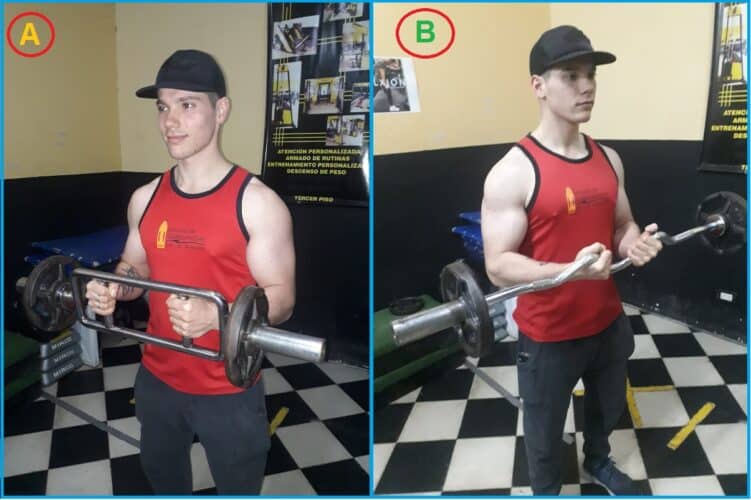
6 variations of Dumbbell Bicep Curl
The dumbbell bicep curl is widely practiced in the gym, with which it is observed that they are performed both standing and seated, or bilaterally or unilaterally.
That said, we will find different bicep exercises with dumbbells, such as: Alternating Curl with Wrist Rotation, Concentrated Bicep Curl, Seated Bicep Curl (incline bench) and Hammer Bicep Curl.
Additionally, Serbest, K (2022), in his study on dumbbell bicep curl, states that increasing only the load in this strength exercise would not have a correlative impact between strength gains and muscle growth, but the angular variables of the elbow must be taken into account.
Bicep Curl with Wrist Rotation
Within bicep exercises, this Curl is mainly characterized by allowing the biceps to perform its full function, as from a biomechanical point of view, its function is a flexor and antepulsor of the arm and above all, a powerful supinator (5).
To do this, compared to the barbell bicep curl, performing it with dumbbells allows working in a freer range of motion and detecting where the weakest point is (15).
Technical aspects to consider:
- Position yourself seated on a bench, with dumbbells at the sides, held in semi-pronation, and with feet on the ground (5 and 15).
- Inhale and flex the elbows, along with an external rotation of the wrist, before the forearms reach the horizontal.
- At the end of the flexion, slightly raise the elbows, and exhale at the end of the movement.
- The musculature involved in these bicep exercises, brachioradialis, brachialis, biceps brachii, anterior deltoid, and to a lesser extent: coracobrachialis and the clavicular head of the pectoralis major (4).
Concentrated Bicep Curl
Basically, these bicep exercises are characterized by lifting the dumbbell towards the shoulder, flexing the elbow, and extending it to continue the movement (15).
Without a doubt, it will have a great stimulus on the biceps and brachialis, and it allows control of the movement, great amplitude, speed, and straightness, and by its name, it predominates over the concentration and intensity of this exercise (5 and 15).
Technical aspects to consider:
- The trainee should be seated, with a single dumbbell, held in supination, with the elbow supported on the inner thigh.
- Inhale and perform elbow flexion, and in the final phase of the movement, exhale (5).
- The spine should be aligned, controlling the movement, avoiding impulses (15).
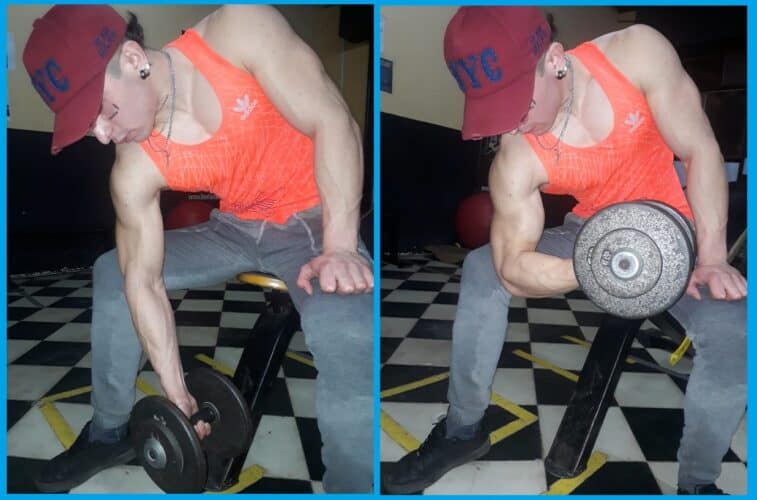
Seated Bicep Curl on Incline Bench
These bicep exercises are a great variant of the Dumbbell Bicep Curl, and it is recommended that the inclination of the bench and the backrest respect the structures of the trainee, as this way it will avoid wear or disadvantages on the shoulder joint (10).
That said, the trainee takes a seated position, with the back supported on the bench backrest, and the dumbbells at the sides of the body with a semi-pronation grip.
Next, perform an inhalation and elbow flexion, with a slight wrist rotation, so as to position the dumbbell at the height of the horizontal, ending the movement with an exhalation and elbow extension.
Mainly, this exercise emphasizes the long head of the biceps brachii, especially the outer part, and to a lesser extent the brachioradialis and the brachialis (6).
For this, Oliveira and collaborators (2014), mention that this exercise has a 95% neuromuscular stimulus, similar to the dumbbell bicep curl.
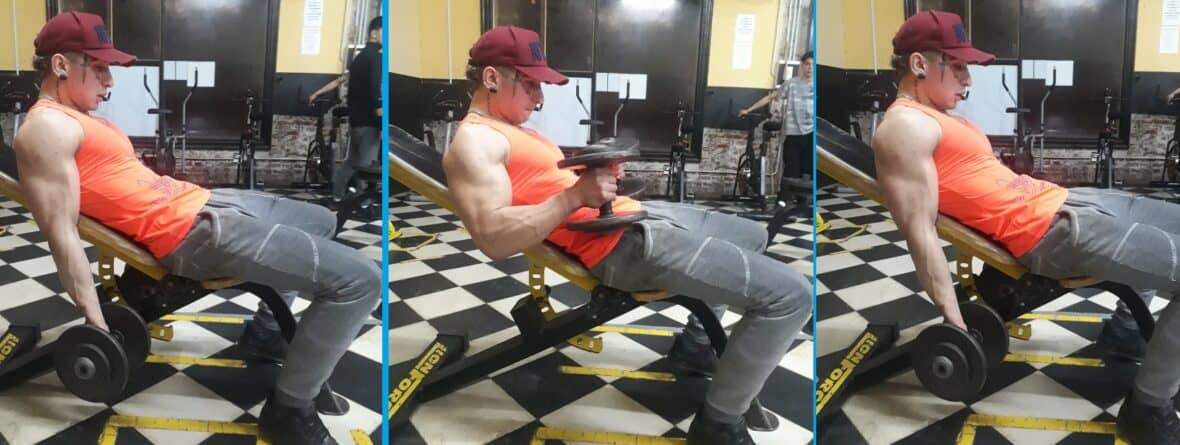
Scott Bench Bicep Curl
These bicep exercises are very good in terms of the strict manner in which they are performed. You should sit on a bench, with elbows supported and extended, in which in the first part of the range of motion, the biceps brachii will receive great stimulus.
As Oliveira and collaborators (2014) state, in their research conducted with dumbbells, they found that 80% of neuromuscular stimulation is at the beginning of the range.
One of the variations of these bicep exercises that this exercise allows is the possibility of performing it on a bench with a pulley, with dumbbells, or with a bar (6).
Preacher Curl with Dumbbells
Another very interesting bicep exercise is the preacher curl with dumbbells, which is characterized by being a unilateral exercise, allowing great stimulation of the biceps brachii and the brachialis.
It is performed with dumbbells, positioning the shoulder joint at 45º, and should begin with the elbow extended.
Since Sato, S and collaborators (2021), in their study on different variations of joint angles for this exercise, obtain favorable results that in 5 weeks of training, there is great muscle thickness and strength gains, on the biceps brachii and the brachialis.

Hammer Bicep Curl
This is one of the best bicep exercises, especially for developing the brachioradialis. On the other hand, it also exercises the anterior biceps brachii, and to a lesser extent, the first and second radials.
To perform the technique of these bicep exercises, you should stand, with the dumbbells held at the sides of the body, in semi-pronation, perform an inhalation and elbow flexion (can be simultaneous or alternating), and exhale in the final phase of movement (5).
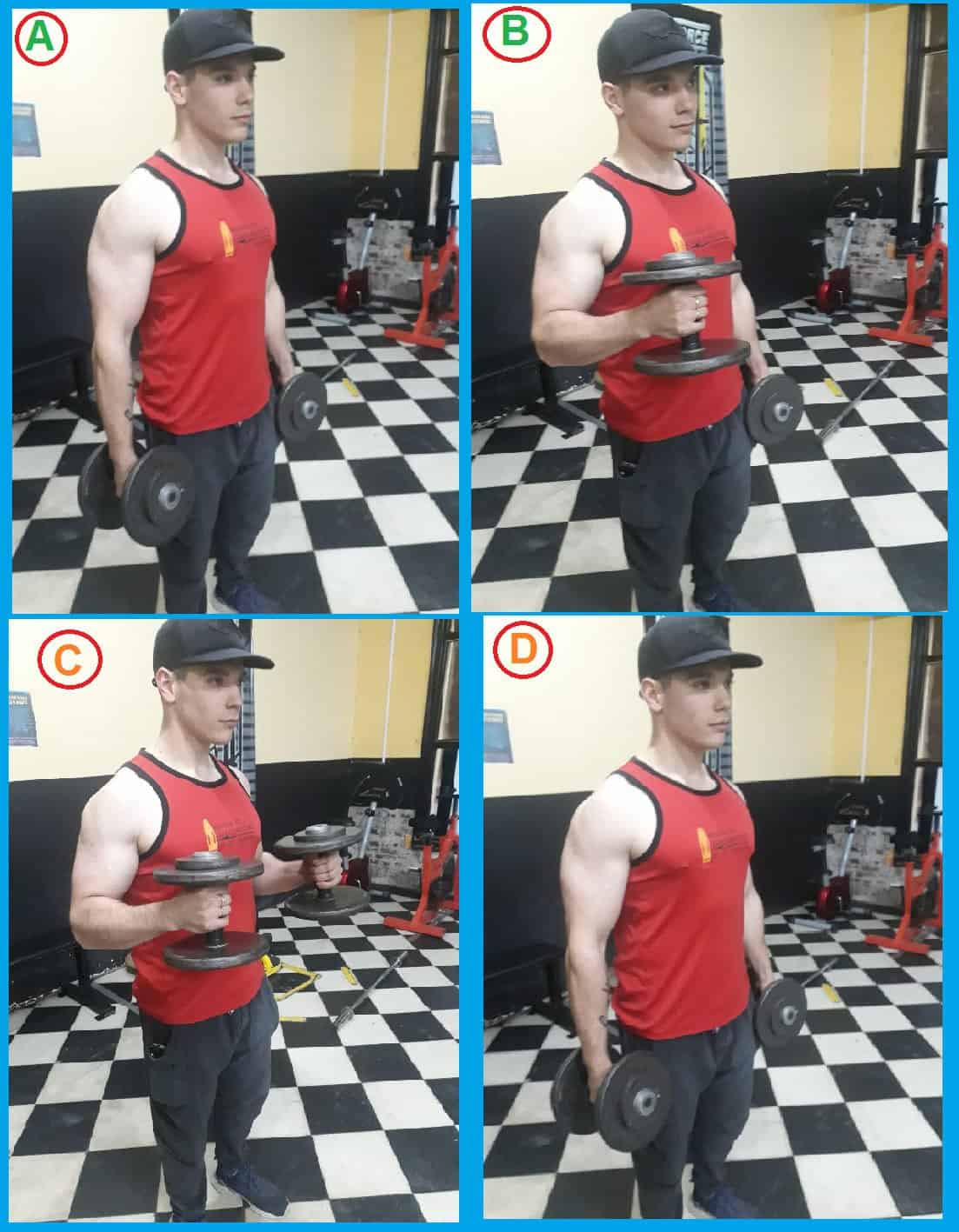
2 variations of Bicep Curl on Pulley
Another great variant of bicep exercises is the use of pulleys, whether standing, seated, or kneeling, bilaterally or unilaterally. For this, the bicep exercises such as: alternate elbow flexion on standing pulley and its variants and biceps with arms crossed on high pulley will be mentioned.
Alternate Elbow Flexion on Pulley
These bicep exercises, with the trainee standing, facing the pulley, and with the handle held in supination, should perform elbow flexion and exhale at the end of the movement, also allowing the effort to be localized on the biceps (6) Another variant is to work with both hands on the low pulley.
Biceps with Arms Crossed on High Pulley
For this bicep exercise, it is essential to stand in the middle of the pulley, holding the pulley handle in supination, inhaling at the beginning of the movement and exhaling at the moment of elbow extension, performing the work on the long portion of the biceps and the brachialis (6) A variant is to perform it unilaterally.
Guidelines for training bicep exercises
For bicep hypertrophy, time under tension is of great importance, as well as intensities and work angles. For this, Barón Sandoval, A and collaborators (2020), in their experimental analysis, found that in bicep lifting, the greatest stimuli were found between 60º and 80º, working on a cadence between 2 to 4 seconds, over the cycle of repetitions.
Additionally, one of the fundamental premises for “muscle growth” is the management of intensity, training variation, and the principle of overload (4).
On the other hand, in a study conducted by Sato, S and collaborators (2021), over 5 weeks, on the preacher curl with dumbbells, they obtained great strength and muscle thickness gains, working with 3 sets of 10 repetitions, starting at 50% and increasing the load by 10% each week.
In other words, the importance of measuring training volume for muscle mass gains is of great importance, as Baz Valle, E and collaborators (2021), mention that to calculate training volume, you should train to failure or near it, in a range of 6 to 20 repetitions.
Among them, load volume is widely used today, which is repetitions x sets x kilograms. That said, Baz Valle, E and collaborators (2021), state that to quantify repetition volume, you should train near failure, or to failure, but not always, as it can cause neuromechanical and hormonal issues. For this, they propose quantifying repetitions in reserve (RIR) from 3 or less.
One of the mentioned investigations proposes working with different load volumes, with trained individuals in programs between 6 to 8 weeks, in which they mention that the investigations conducted on elbow flexor-extensors worked at 3 sets of 8 to 12 repetitions, 3 sets of 25 to 35 repetitions, or 3 sets of 2 to 4 repetitions.
With which it can be said that the “star” repetition range for working bicep exercises would be 12 to 16 repetitions at an RIR 0-3.
Conclusions on bicep exercises
Firstly, the main musculature of the anterior arm region will take all the work stimulus in bicep exercises, not forgetting that the biceps brachii, brachialis, and coracobrachialis will benefit from these bicep exercises, especially in the elbow flexion phase.
In other words, the barbell bicep curl is an exercise that is widely practiced in the gym, it can be performed with a straight bar, W bar, or Roman bar, and it can be beneficial for people who experience wrist pain, the use of W or Roman bar.
That said, within the great variation of bicep exercises, we find Dumbbell Curls and their different ways of performing them, simultaneously or alternately, as it will allow working with freer ranges of motion and focus the work on the weaker aspects or points in the range of motion of this exercise.
To get the most out of these bicep exercises, the evidence suggests working in complete range of motion angles, where between 60º to 90º, according to Barón Sandoval, A and collaborators (2020), the best stimulus will be found, depending on the exercise and the elbow angle dispositions.
In this way, if your goal is muscle hypertrophy, looking for bicep exercises that stimulate the required range of motion for each exercise, measuring volume, intensity, and progressive overload, will lead you to get the most out of it.
Baz Valle, E and collaborators (2021), mention that to calculate the training volume, you should train to failure or near it, in a range of 6 to 20 repetitions.
Once the Bicep Exercises presented above are collected, it would be necessary to remember that these exercises alone are not capable of achieving a goal in a clear and concise manner, being necessary to maintain and perform a good complete exercise routine based on a plan according to the characteristics and context of each person.
For this, we must consider volume, intensity, load, nutrition, and rest among other factors.
Podcast “3 types of bicep exercises”: Play in new window |
Subscribe to Apple Podcasts | Spotify | Google Podcasts |
Bibliographic references
- Barón Sandoval, A. (2020). Analysis of bicep curl in muscle hypertrophy. Bicep exercises. University of the Andes.
- Baz-Valle, Eneko 1 ; Fontes-Villalba, Maelán 2 ; Santos-Concejero, Jordania 1 Total number of series as a method of quantifying training volume for muscle hypertrophy: a systematic review, Journal of Strength and Conditioning Research: March 2021 – Volume 35 – Number 3 – p 870-878 doi: 10.1519/JSC.0000000000002776. (Link)
- Drake, R., Volg, W., and Mitchell, A. (2005). GRAY Anatomy for Students. El Sevier Editorial. Madrid. Spain.
- Fernando. (2018). Muscle Training Systems. Blog musculación.net.
- Frederic, D. (2004). Guide to Muscle Movement. Anatomical Description. 4th edition. Paidotribo Editorial.
- Frederic, D. (2011). Guide to Muscle Movement. Anatomical Description. 6th edition. Paidotribo Editorial.
- Gutierrez Errazuriz, B. (2019). Training system for biceps brachii muscle growth in novice bodybuilders. Faculty of Physical Education, Sport and Recreation. University of Guayaquil.
- Gusmão, Luiz Carlos Buarque de, Sousa-Rodrigues, Célio Fernando de, dos Santos, Eduardo José Lopes, & Pinto, Walton Nolasco Araujo. (2012). Comparative Morphometric Study between the Biceps Brachii and Brachialis Muscles to Establish the Main Elbow Flexor Muscle. Bicep exercises. International Journal of Morphology, 30(1), 185-187.
- López Miñarro, P and collaborators. (2007). Sagittal disposition of the lumbar and thoracic spine in the standing barbell bicep curl exercise. Faculty of Education. University of Murcia. Espinardo University Campus, 30100 (Murcia), Spain.
- Oliveira LF, Matta TT, Alves DS, Garcia MA, Vieira TM. Effect of the shoulder position on the biceps brachii emg in different dumbbell curls. J Sports Sci Med. 2009 Mar 1;8(1):24-9. PMID: 24150552; PMCID: PMC3737788.
- Salinas, P. (2017). Biceps Brachii, origin and insertion, functions, pathologies. Lifeder Blog of anatomy and physiology.
- Sato S, Yoshida R, Kiyono R, Yahata K, Yasaka K, Nunes JP, Nosaka K, Nakamura M. Elbow Joint Angles in Elbow Flexor Unilateral Resistance Exercise Training Determine Its Effects on Muscle Strength and Thickness of Trained and Non-trained Arms. Front Physiol. 2021 Sep 16;12:734509. doi: 10.3389/fphys.2021.734509. PMID: 34616309; PMCID: PMC8489980.
- Serbest, K. (2021). A Biomechanical Analysis of Dumbbell Curl and Investigation of the Effects of Increasing Loads on Biceps Brachii Using A Finite Element Model. Sakarya Uygulamali Bilimler Universitesi.
- Tortora, G., and Grabowski, S. (2003). Principles of Anatomy and Physiology. Bicep exercises. 9th edition. Mexican Editorial. Registration number 723.
- Vella, M. (2007). Anatomy and Muscle Training for Strength and Physical Condition Development. Bicep exercises. Paidotribo Editorial.
